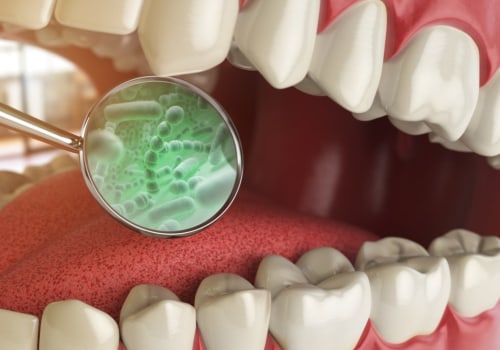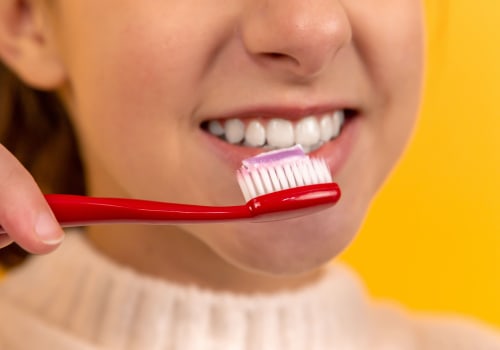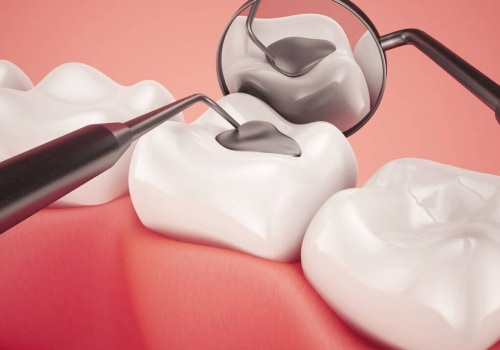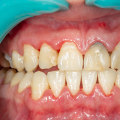Smoking or tobacco use is a major contributor to gum disease. The long-term effects of smoking or tobacco use on gum health can be far-reaching and devastating. There are many ways in which smoking or tobacco use affects the health of gums, from interfering with tissue regeneration to increasing the risk for infection. This article will explore the numerous ways in which smoking or tobacco use can contribute to gum disease, as well as provide tips on how to reduce the risks. Gum disease, also known as periodontal disease, is an infection of the gums and tissues that support the teeth.
It is caused by bacteria that slowly accumulate in the mouth, forming a sticky film known as plaque. If plaque is not removed regularly through brushing and flossing, it can harden into tartar, which can lead to gum inflammation and infection. Smoking or tobacco use can make gum disease worse by reducing the amount of saliva in the mouth, which can lead to dry mouth and create an environment for bacteria growth. Additionally, smokers are at an increased risk for developing periodontal pockets, which are spaces between the teeth and gums where bacteria can accumulate and cause further damage. The effects of smoking or tobacco use on gum disease range from increasing the risk of infection to making treatment less effective. In this article, we'll explore how smoking or tobacco use contributes to gum disease and how people can reduce their risks. Smoking or using tobacco has long been linked to a variety of health issues, including gum disease.
This article will explore the effects of smoking or tobacco use on gum disease, as well as the potential risks and treatments available for those affected. Research has shown that those who smoke or use tobacco are more likely to develop gum disease. One study found that smokers were more than twice as likely to develop periodontal disease than non-smokers. Additionally, those who smoke or use tobacco are more likely to experience increased inflammation of the gums, bone loss, and an increased risk of infection.
Smokers are also more likely to experience an increase in periodontal pockets, which can cause additional damage to the gums and teeth. The complications of gum disease can be severe. Tooth loss is a common complication of advanced gum disease, and it can also increase the risk of other health problems such as stroke, heart disease, and diabetes. Additionally, gum disease can cause bad breath, receding gums, and pain when chewing.
It is important to be aware of the signs and symptoms of gum disease, so that it can be detected and treated early. Common signs include swollen or tender gums, red or bleeding gums, receding gums, persistent bad breath, and loose teeth. If any of these signs are present, it is important to visit a dentist as soon as possible for a professional diagnosis and treatment plan. Treatment for gum disease depends on the severity of the condition.
In mild cases, lifestyle changes such as quitting smoking/tobacco use, improving oral hygiene, eating a healthy diet, and visiting a dentist regularly may be enough to improve symptoms. In more severe cases, antibiotics may be prescribed to reduce inflammation and infection. Additionally, surgery may be necessary in some cases to remove damaged tissue or repair any structural damage that has occurred. Several case studies have been conducted to illustrate the effects of smoking or tobacco use on gum disease.
One study found that smokers were four times more likely to develop periodontal disease than non-smokers. Another study found that the risk of developing gum disease increased by 30-40% for those who smoked more than 10 cigarettes per day. To reduce the risk of gum disease due to smoking or tobacco use, it is important to take preventive measures. Quitting smoking/tobacco use completely is the best way to reduce the risk.
For those who are unable or unwilling to quit completely, reducing smoking/tobacco use can still have a positive effect on gum health. Additionally, good oral hygiene practices such as brushing twice a day with fluoride toothpaste and flossing daily can help reduce the risk of gum disease. Eating a healthy diet and visiting a dentist regularly for checkups and cleanings can also help keep the gums healthy.
Potential Complications of Gum Disease
Tooth LossSmoking or using tobacco has been linked to an increased risk of tooth loss due to gum disease. This is because smoking or using tobacco can increase the rate at which plaque builds up on the teeth, leading to an increased risk of gum disease.As gum disease progresses, the bone and tissue around the teeth become more damaged, which can lead to tooth loss.
Other Health Issues
In addition to tooth loss, smoking or using tobacco use can also increase the risk of other health issues, such as stroke, heart disease, and diabetes. This is because smoking or using tobacco can cause inflammation in the body, which can put a strain on the cardiovascular system and increase the risk of these conditions. Additionally, smoking or using tobacco can lead to a decrease in the body’s ability to fight off infection, which can also increase the risk of these conditions.Case Studies
There are a number of case studies that illustrate the effects of smoking or tobacco use on gum disease. One such case study involved a 65-year-old man with a history of smoking for more than 30 years.After a routine dental exam, it was discovered that he had advanced periodontal disease. Upon further examination, it was determined that the man’s long-term smoking habit had contributed to the development of the disease. Another case study involved an 18-year-old man who had also been a long-term smoker. He had developed severe periodontal disease despite having perfect oral hygiene and visiting the dentist regularly.
Upon further examination, it was revealed that his smoking habit had caused the gum disease. These two cases illustrate how smoking or tobacco use can increase the risk of gum disease, even when other preventive measures are taken.
Treatments for Gum Disease
When it comes to treating gum disease, there are a variety of options available. These include medications, lifestyle changes, and surgery.MedicationMedications used to treat gum disease include antibiotics and antimicrobial mouthwashes. Antibiotics can help reduce inflammation and control the growth of bacteria that cause gum disease. Antimicrobial mouthwashes may be used to reduce plaque and tartar buildup.
Lifestyle Changes
Making lifestyle changes can help reduce the effects of gum disease.These changes may include quitting smoking or using other forms of tobacco, improving oral hygiene, and eating a healthy diet.
Surgery
In severe cases of gum disease, surgery may be necessary. This may involve gum grafts, tissue regeneration, or bone grafts to restore lost tissue. Additionally, surgery may be used to remove excess tissue, reduce pocket depths, or reshape the gums.Signs and Symptoms of Gum Disease
Gum disease, also known as periodontal disease, is an infection of the gum and bone that support the teeth. It can be caused by a variety of factors, including smoking or using tobacco. Common signs and symptoms of gum disease include red, swollen, and bleeding gums; receding gums; bad breath; loose teeth; and pain when chewing. In severe cases, gum disease can lead to tooth loss. The best way to prevent gum disease is to practice good oral hygiene, including brushing twice daily and flossing at least once a day.Regular dental check-ups are also important for early detection and management of any signs or symptoms. If gum disease is detected in its early stages, it can usually be treated with professional cleaning and improved oral hygiene practices. If left untreated, gum disease can cause serious health problems. It can lead to bone and tooth loss, and has been linked to an increased risk of heart disease, stroke, and other illnesses. Therefore, it is important to take action if you experience any of the signs or symptoms of gum disease.
Preventing Gum Disease Due to Smoking or Tobacco Use
Smoking or using tobacco has long been linked to gum disease, a condition which can result in painful and unsightly inflammation of the gums.The good news is that there are steps you can take to reduce your risk of developing gum disease due to smoking or tobacco use. Quitting smoking or using tobacco is the most effective way to prevent gum disease. However, if quitting is not an option, reducing your smoking/tobacco use can help reduce the risk of developing gum disease. Other prevention methods include practicing good oral hygiene, eating a healthy diet, and visiting a dentist regularly.
Good oral hygiene is essential for preventing gum disease. Brushing your teeth twice a day with fluoride toothpaste and flossing daily can help prevent gum disease by removing plaque and bacteria from the gums. Eating a healthy diet is also important for maintaining good oral health; foods rich in calcium, such as yogurt and leafy greens, are particularly beneficial for strengthening the teeth and gums. Visiting a dentist regularly for check-ups and cleanings can also help prevent gum disease, as dentists are able to identify potential problems early on and can provide treatment if necessary.
By following these steps, you can reduce your risk of developing gum disease due to smoking or tobacco use. Quitting smoking/tobacco use is the best way to prevent gum disease, but if quitting is not an option, then reducing your use and following good oral hygiene practices can help protect your gums. Eating a healthy diet and visiting a dentist regularly are also important steps in preventing gum disease.
The Link Between Smoking and Tobacco Use and Gum Disease
Smoking or using tobacco has long been known to be a major risk factor for gum disease. Research has shown that those who use tobacco are more likely to develop periodontal (gum) disease than those who do not.It has also been linked to an increased risk of developing more severe forms of the disease. The exact cause of this connection is still not fully understood, but it is thought that smoking or using tobacco use can damage the tissues that support the teeth, allowing bacteria to penetrate and infect the gums. This can lead to inflammation and gum disease. Additionally, smoking or using tobacco can also reduce the body’s ability to fight infection, making it more difficult for the body to fight off gum disease. Studies have also found that smoking or using tobacco can lead to an increase in plaque buildup on the teeth, which can contribute to gum disease. The tar and nicotine present in smoke and tobacco can also cause irritation of the gums, increasing the risk of developing gingivitis. The effects of smoking or using tobacco on gum disease are thought to be cumulative, meaning that the longer someone smokes or uses tobacco, the greater their risk of developing gum disease.
Quitting smoking or using tobacco can help reduce the risk of developing gum disease, but it is important to note that it may take a few years for the full benefits to be seen. It is important for those who smoke or use tobacco to be aware of their increased risk of developing gum disease and take steps to reduce their risk. This includes regular visits to the dentist for check-ups and cleaning, brushing and flossing regularly, and quitting smoking or using tobacco if possible. This article has explored the link between smoking or tobacco use and gum disease, as well as the potential complications and treatments available for those affected. It is important for people who smoke or use tobacco to be aware of the risks associated with gum disease, as early detection and treatment can help reduce the risk of serious complications. Regular dental visits are important to ensure that any signs of gum disease are caught early on. It is also important to take steps to prevent gum disease due to smoking or tobacco use.
This includes quitting smoking or reducing tobacco use, practicing good oral hygiene, and eating a balanced diet. With proper care, people who smoke or use tobacco can still maintain healthy gums.






